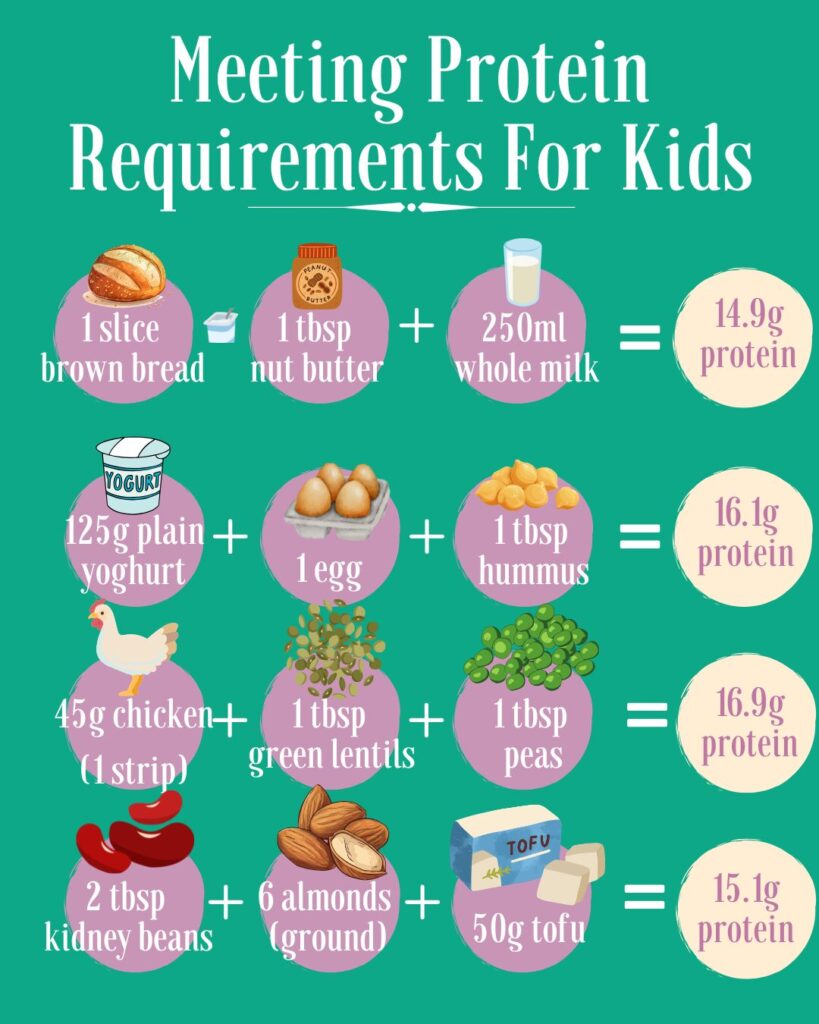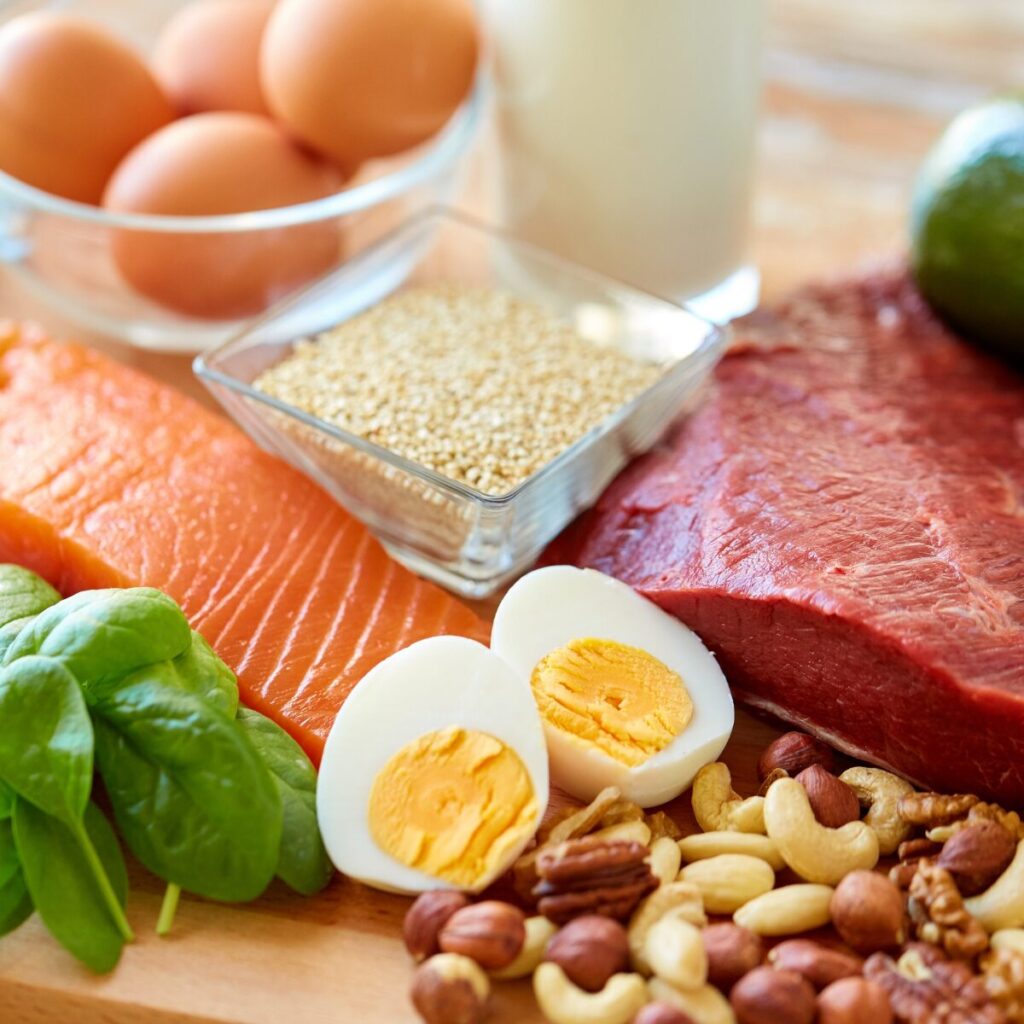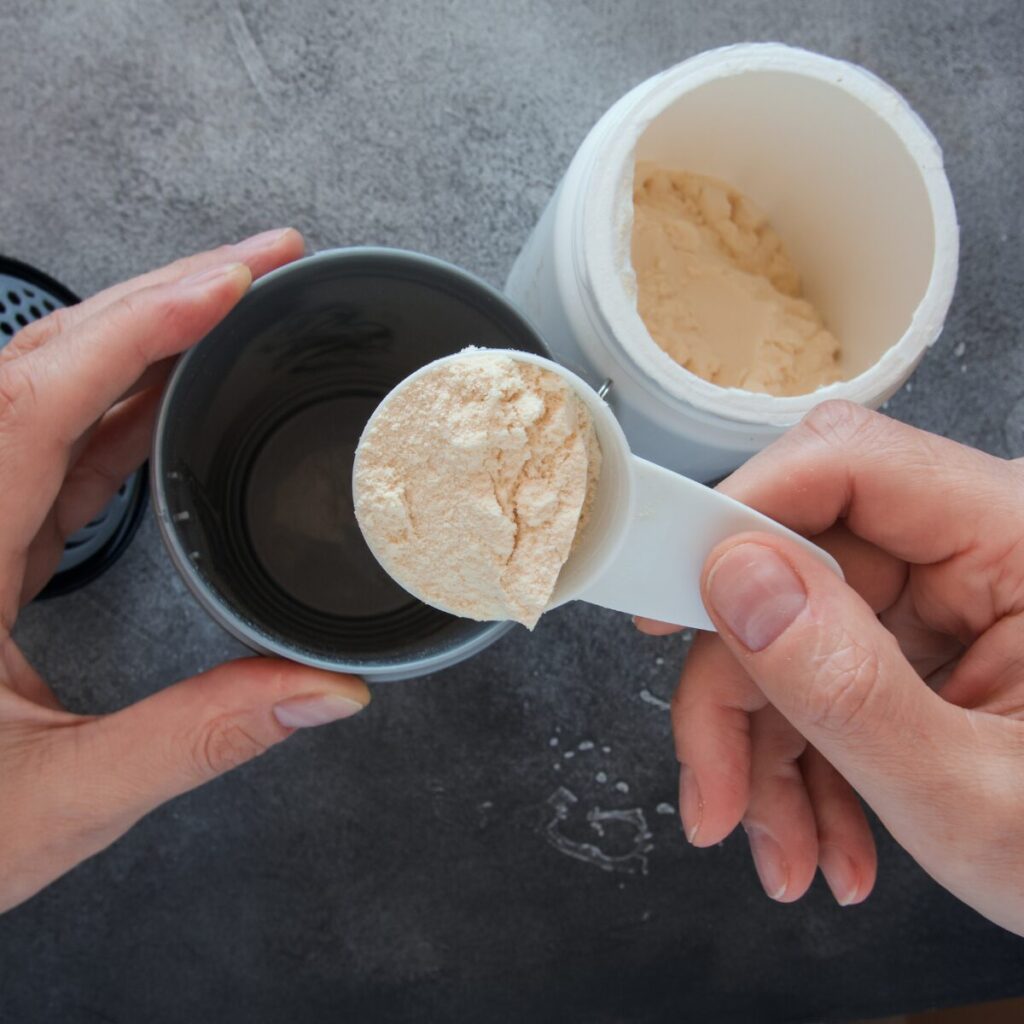There is a growing trend of protein powders in the UK and worldwide and parents are often asking me if it’s safe to give their little one’s foods or drinks with protein powder in them. Often parents might want this option if they are concerned about their child’s growth, fussy eating, or general nutrition intakes. Or they may be consuming protein powders themselves and wanting to share food with their children. Either way, lots of parents want to know if their child needs protein powder or if it’s safe to offer it!
In this blog we shall uncover if protein powders are actually needed and in what circumstances.
How much protein does my child need?
Protein is an essential nutrient needed for growth, maintenance and repair for the body. To help clarify protein needs for children, I’ve shared an in-depth discussion on this topic in my blog “How much protein does my toddler need?”.
However, I’ve outlined some of the information for you below a
Recommended Daily Protein Intake by Age:
1- 3 years
14.5g protein per day
4 – 6 years
19.7 grams of protein per day
7 – 10 years
28.3 grams of protein per day
To provide a clearer perspective, my blog also illustrates what these recommended protein amounts look like in practical portion sizes for each age group. The good news is that most children easily meet their protein needs through their regular diets without requiring additional effort or supplementation.
In fact, a recent SACN report in 2024 on the feeding of 1-5 year old children says:
“‘mean intakes of protein were above the reference nutrient intake (RNI) and higher total protein intake in children aged 1 to 5 years is associated with higher BMI in childhood”.
Other data shows that children aged 1.5-3 years consume on average 41g of protein per day and 4-10 year olds have an average intake of 52.9g of protein per day. These figures significantly exceed the actual requirements for children in these age groups, as outlined above.
The graphic below also demonstrates how easily you can help children meet their protein requirements throughout the day.

Foods high in protein
There are many accessible, inexpensive protein-rich foods, and these are some of the primary sources that young children commonly rely on to meet their protein needs.
- Dairy (milk, yogurt, cheese) or plant-based fortified dairy alternatives
- Eggs
- Meat, poultry, fish
- Beans, lentils, tofu
- Nut butters (age-appropriate)

Some foods provide a source of protein even though they might not immediately come to mind as a “protein-rich” food option. While these foods may not be as high in protein as typical sources like meat or beans, they still contribute to overall protein intakes. Examples include pasta, rice, bread, oats and other grains.
Additionally, vegetables like spinach, broccoli, and sweet corn, as well as nuts like peanuts or almonds, also contain protein. Even foods such as potatoes and certain fruits like avocados provide small amounts of protein, making them surprising contributors to protein in the diet.
What is protein powder for?
Protein powder is essentially a food supplement that many adults use to help them easily and conveniently up their protein intake. Protein is an important macronutrient in the diet and is needed for growth and repair, but many adults use protein powders to provide their diet with excess protein for fitness, training or to aid muscle building.
Protein powders can be a really simple way of easily getting extra protein, that might be challenging to get in a balanced diet alone when doing excess training. Whether it’s really needed is questionable, unless you’re an athlete, rigorously train or simply struggle to eat enough calories.
Many parents worry – usually unnecessarily – about young children’s protein intakes, thinking that because children are fussy, refuse numerous foods or perhaps don’t eat much meat that they might be low in protein. This has led many parents to question whether protein powders might be beneficial for children too.
What are protein powders made up of?
There are lots of different types of protein powders on the market. Including those made from either animal protein (whey, casein) or plant based protein such as soy, pea, hemp and rice protein.
The base ingredient e.g. soy will be processed to extract the protein content to different degrees. Either concentrated or isolated. Concentrated protein powders have a lower protein content and keep more of the original ingredients, whereas Isolate powders extract most (90% +) of the protein to remove more of the fat and carbohydrates. These will undergo more processing to get this concentration.
Many powders will have added ingredients such as sweeteners, flavourings, thickeners and be fortified with vitamins and minerals to make them taste better and add more nutritional value – this is where you might need to be especially careful with giving them to young children. Protein powders may contain high levels of vitamins and minerals which are unsuitable for young children. New guidance also recommends young children should minimise their intake of sweeteners. Also, some of the additives found within protein powders might not be suitable for young children.
When can I offer protein powder for children?
There is no official UK guidance on the age you can give protein powder to your child. However the NHS does say that whole foods should be prioritised.
According to some protein powder brands such as Huel. Protein powders are NOT recommended for children under 4 years of age
As you can see from the above, most children will not need protein powders and don’t need much effort to get their recommended protein intakes. It’s always best to take a food first approach when feeding young children and this goes for protein intakes too.
There are some special circumstances when protein powders might be suggested for young children by health care professionals. This is beyond the scope of this blog, but might occur if children have protein deficiency (very rare in the UK), if children have certain medical conditions, extreme dietary restrictions, very selective eating or those living in poverty. In any of these circumstances you’d need to talk to a health care professional about your child’s diet.
Protein powder may be considered for children who can’t get enough protein from their diet due to being underweight or having certain metabolic conditions. However, it is important to consult a healthcare professional before adding protein supplements into your little one’s diet and this generally wouldn’t be advised at home or for very young children.
Are protein powders safe for small children?
It depends on the child. For most young children they are not necessary and you could be doing more harm than good if they are getting sufficient protein already. You can read more about the potential risks below.
Many of the protein powders also have added Ingredients such as sugars, sweeteners, artificial flavourings, and thickeners. Again these added ingredients are unnecessary and not healthy for children. The NHS recommends not giving added sugar to young children under 2 years.
In a US study by the clean label project of popular protein powders, they found half of them to have high levels of lead and cadmium. It is unclear if this represents the UK too.
Risks of protein powders

If you are considering protein powders for your child, then you will want to learn about the potential risks. Here are some:
- They can contain added ingredients such as sugar, sweeteners, thickeners and additives that are not necessary or recommended.
- Protein powders for kids are not regulated like any baby or toddler foods would be and they are also not aimed at young children so it would be easy to over supplement.
- If you start to rely on them as a substitute for real food it may interfere with your child’s relationship with food and the development of their healthy eating habits. Largely because these protein supplements are unnecessary.
Tips for incorporating protein into meals and snacks
If your child doesn’t like these high protein foods on their own then there are easy ways to incorporate them into meals without them being so noticeable. I don’t mean hide them but use them to add a bit more protein into meals – adding extras to meals!
- Use yoghurt in sauces, smoothies, soups or even yoghurt bark
- Tofu in sauces
- Make pancakes and waffles using eggs
- Tinned fish can be blended into tomato sauces
- Beans and lentils blended into sauces or added whole to dishes
- Nut butters added to cereals, spread on toast or milled nuts sprinkled onto foods
- Grated or melted cheese in sauces or added onto dishes like pasta.
In most cases, a protein powder is not needed or recommended for young children. It is best to focus on balanced, whole-foods rather than offering protein powders. In some cases they can be helpful but these are the EXCEPTIONS and would be recommended only under advice from a health care professional who knows your child. If you are in doubt, consult a registered nutritionist or GP.